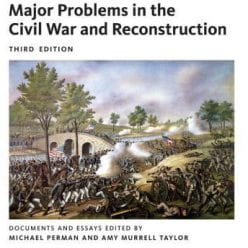Gallman, Matthew J. The North Fights the Civil War. American Ways Series. Chicago: Rowman & Littlefield Publishing Group, 1994.
In his book intended for college students, Matthew J. Gallman, a professor of history at the University of Florida, highlights the “continuities” of the North’s antebellum and wartime practices, arguing that the North underwent a series of adjustments, rather than a full-scale transformation, as a result of the Civil War. Gallman utilizes new social and economic history, including emotional and intellectual responses to the war, the war’s impact on the economy, and the effect on racial attitudes and the status of African American’s civil liberties, as well as the traditional political, constitutional, and military history when emphasizing that no drastic change occurred in the North during the war. Gallman also focuses heavily on his assertion that traditional and localized volunteer efforts, rather than centralized federal efforts, seen throughout early patterns of enlistment proves that the Civil War did not bring drastic change, rather, society stayed consistent with a few minor adjustments. Gallman does admit that some areas experienced changes, such as women “cutting their political teeth” by getting involved in political organizations and the growth of federal and executive power during wartime, these were still only adjustments, as Gallman emphasizes that a majority of men still controlled politics and ruled in Washington and that federal and executive powers, after Appomattox, returned to what they had been in 1861, therefore there was no drastic nor long-lasting change. Similarly, Gallman illustrates how African Americans may have gained their freedom, but they still faced racism and oppression, therefore these were only adjustments as a result of the war. Gallman’s book is useful as it attempts to disprove the common belief that the Civil War brought drastic change, while in reality, African Americans still faced oppression, men still dominated the political sphere, and the North did not see any real change in industrialization.
Geary, James W. We Need Men: The Union Draft in the Civil War. Northern Illinois University Press, 1991.
In his book, Geary, a reference librarian at Kent State University and a Vietnam War veteran, details the efforts of the federal government to enlist men into the war, as well as Republicans’ need to modify the draft laws to accommodate to the Democrat minority in Congress. Throughout his work, Geary specifically focuses on the military aspect of the draft and the laws created to raise an army, rather than examining the social history of the draft, including the demographics of soldiers and active resistance to draft efforts. Through focusing on military history, Geary argues that the draft that emerged in the North, came as a result of a changing conditions, new short-term needs, and pressures, not as a result of a long-term mobilization plan by the federal government. Taking a deeper look into the draft, beyond the administrative actions, Geary focuses on the officials’ efforts to strengthen an “inefficient system” rather than making the draft more favorable to the public. Geary also takes the position that the draft was not undemocratic, as working-class individuals were able to pay the three-hundred-dollar fee or find a substitute with private or public assistance, rather than enlist in the Army themselves. This work is useful as Geary illuminates the administrative history of the draft, as well as focuses on the officials’ efforts to support an inefficient system, without bringing into account any outside factors and events surrounding the draft effort in the North.

Neely, Mark E. The Union Divided: Party Conflict in the Civil War North. Cambridge, Mass.: Harvard University Press, 2002.
In the book The Union Divided: Party Conflict in the Civil War North, historian and former McCabe Greer Professor in the American Civil War Era at Pennsylvania State University tackles the widely held and prominent belief on subject of politics on the Northern Home front during the civil war. Neely dismantles Eric McKitrick’s “two-party thesis” that the two-party system in the Union aided in the Union in it’s victory as the competition between the parties elected highly talented men to public office and gave state political leaders an incentive to cooperate with the federal government due to a desire for party success. Utilizing newspapers, which were highly partisan during the era, Neely argues that McKitrick’s thesis is incorrect, as the two-party system in the North almost cost the Union the war, due to it promoting discontent, provoking wasteful and disruptive partisan quarrels, and ultimately undermining morale in the North. Nelly emphasizes that among the two parties, there was still a functioning patronage system, a refusal by politicians to set aside their part’s interests, a highly partisan press, a lack of concern over freedom of the press, the growth of the extremist wings of both parties, the Radical Republicans and the Peace Democrats, and the Democrats which were “essentially useless.” Neely’s book is useful as it not only dismantles McKitrick’s thesis, but also gives insight into the two-party system in the North throughout the course of the war and how the extreme partisanship did more harm than good.





